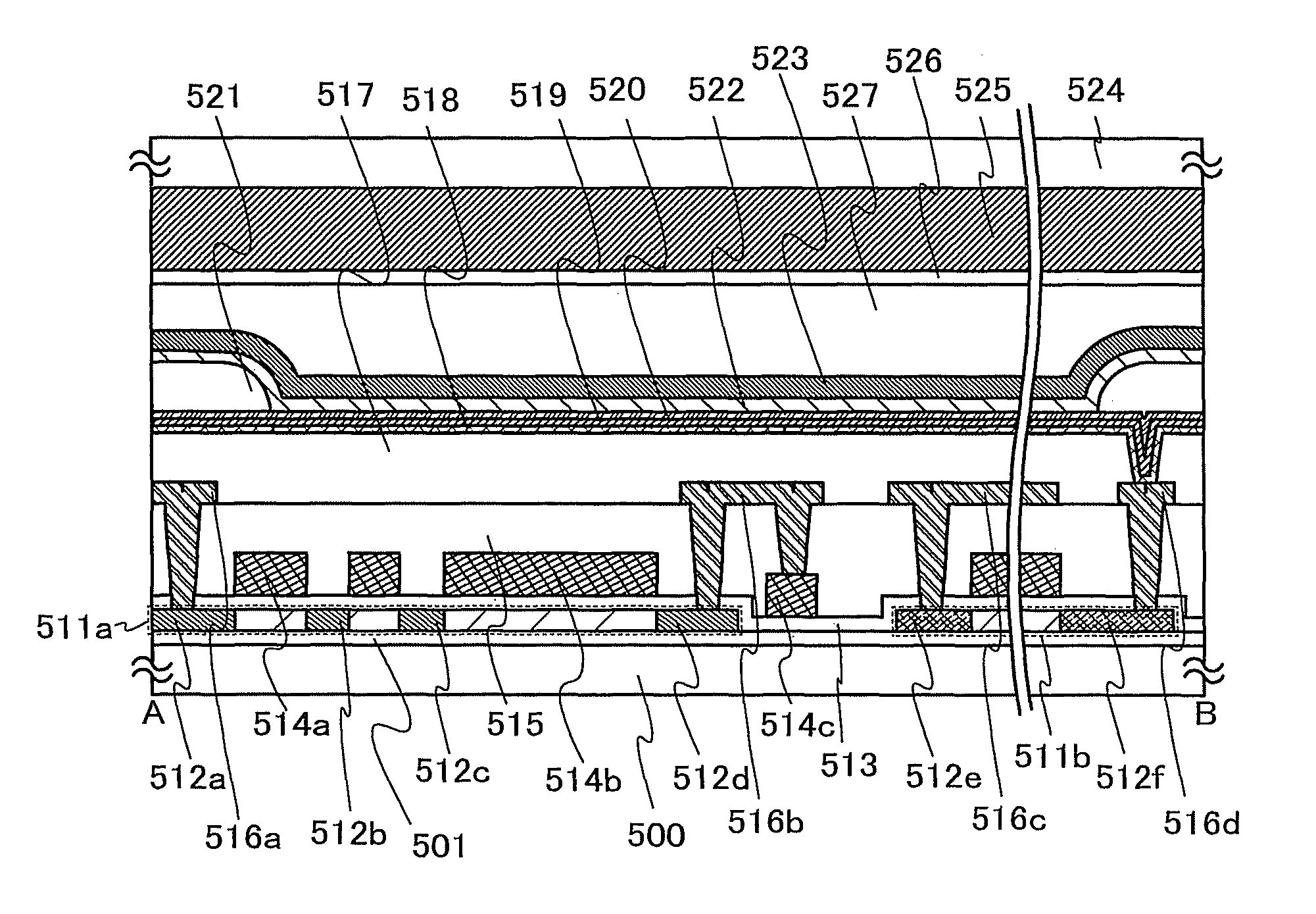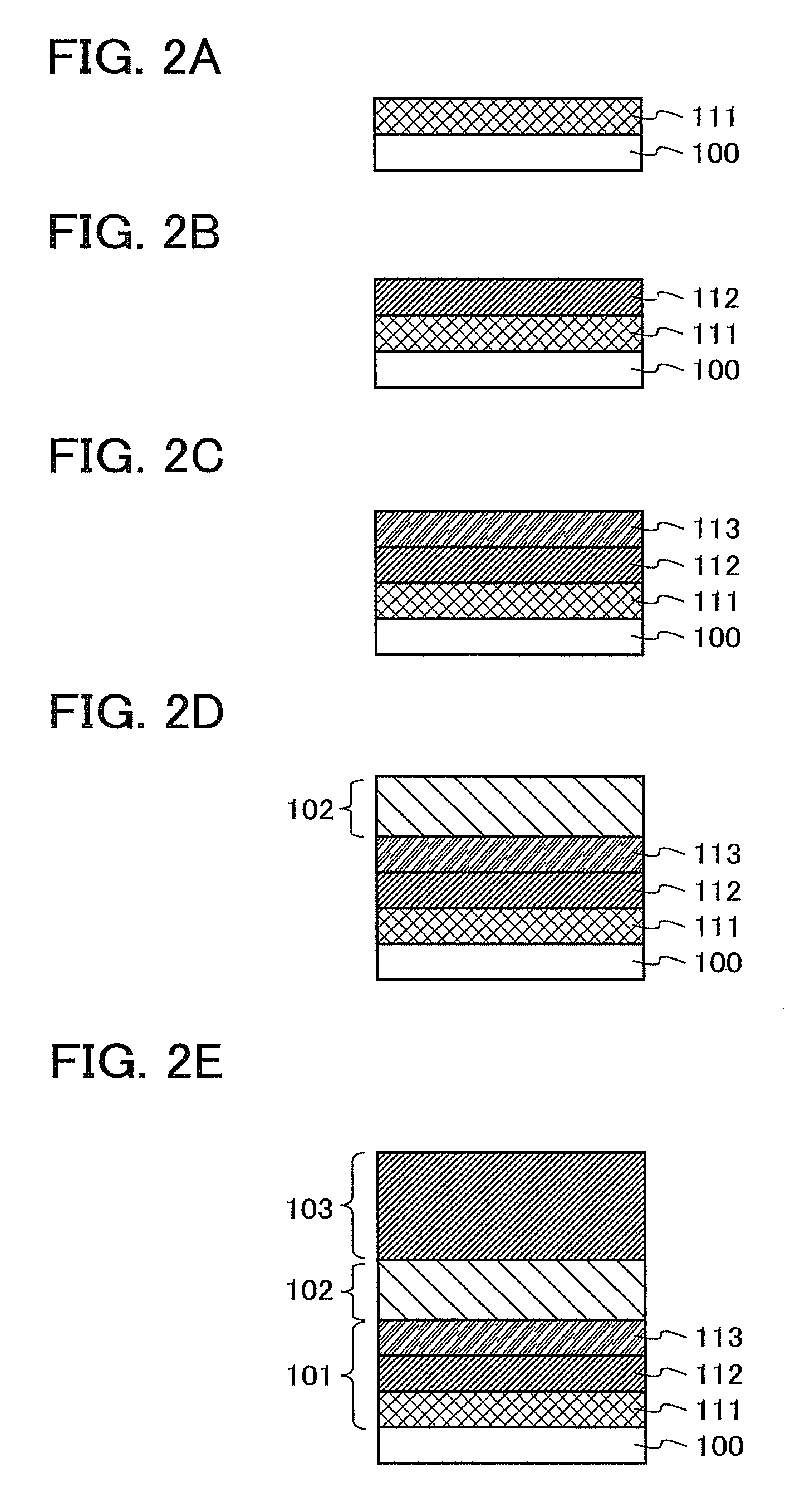Light-emitting element including electrode of three layers
a technology of light-emitting elements and electrodes, which is applied in the field of light-emitting elements, can solve the problems of insufficient element characteristics of conventional light-emitting elements and needs further improvement, and achieve the effects of reducing driving voltage, improving element characteristics, and reducing voltage loss
- Summary
- Abstract
- Description
- Claims
- Application Information
AI Technical Summary
Benefits of technology
Problems solved by technology
Method used
Image
Examples
embodiment 1
[0028]In this embodiment, an example of a light-emitting element will be described.
[0029]A structural example of a light-emitting element in this embodiment will be described with reference to FIGS. 1A and 1B. FIGS. 1A and 1B illustrate the structural example of the light-emitting element in this embodiment.
[0030]The light-emitting element includes, as shown in FIG. 1A, an electrode layer (also referred to as ED) 101, a light-emitting layer (also referred to as LE) 102, and an electrode layer 103.
[0031]Note that an electrode layer is a layer functioning as an electrode.
[0032]The electrode layer 101 functions as an electrode of the light-emitting element.
[0033]The light-emitting layer 102 emits light with a particular color by application of voltage. The light-emitting layer 102 includes M (M is a natural number) light-emitting units.
[0034]Voltage generally refers to a difference between potentials at two points (also referred to as a potential difference). However, values of both a ...
embodiment 2
[0066]In this embodiment, structural examples of a light-emitting layer (LE) of the light-emitting element in the above embodiment will be described.
[0067]The light-emitting layer includes M light-emitting units (also referred to as LEU).
[0068]The structural examples of the light-emitting unit in this embodiment will be described with reference to FIGS. 3A to 3D. FIGS. 3A to 3D are schematic cross-sectional views each illustrate the structural example of the light-emitting unit in this embodiment.
[0069]A light-emitting unit illustrated in FIG. 3A includes an electroluminescence layer (also referred to as ELL) 121a.
[0070]The electroluminescence layer 121a includes a light-emitting material.
[0071]A light-emitting unit illustrated in FIG. 3B includes the electroluminescence layer 121b, a hole-injection layer (also referred to as HIL) 122, a hole-transport layer (also referred to as HTL) 123, an electron-transport layer (also referred to as ETL) 124, and an electron-injection layer (al...
embodiment 3
[0145]In this embodiment, an example of a display device provided with the light-emitting element in the above embodiment in a pixel portion will be described.
[0146]First, an example of the display device in this embodiment will be described with reference to FIG. 4. FIG. 4 is a diagram for explaining the display device in this embodiment.
[0147]The display device illustrated in FIG. 4 includes a display driving portion DDRV and a pixel portion PIX.
[0148]The display driving portion DDRV controls display operation in the display device.
[0149]The pixel portion PIX performs the display operation.
[0150]The display device illustrated in FIG. 4 includes a driver circuit (also referred to as DRV) 301, a driver circuit 302, and a plurality of display circuits (also referred to as DISP) 305.
[0151]The driver circuit 301 is provided for or the display driving portion DDRV. The driver circuit 301 has a function of selecting the display circuit 305.
[0152]The driver circuit 301 has a shift registe...
PUM
 Login to View More
Login to View More Abstract
Description
Claims
Application Information
 Login to View More
Login to View More - R&D
- Intellectual Property
- Life Sciences
- Materials
- Tech Scout
- Unparalleled Data Quality
- Higher Quality Content
- 60% Fewer Hallucinations
Browse by: Latest US Patents, China's latest patents, Technical Efficacy Thesaurus, Application Domain, Technology Topic, Popular Technical Reports.
© 2025 PatSnap. All rights reserved.Legal|Privacy policy|Modern Slavery Act Transparency Statement|Sitemap|About US| Contact US: help@patsnap.com



